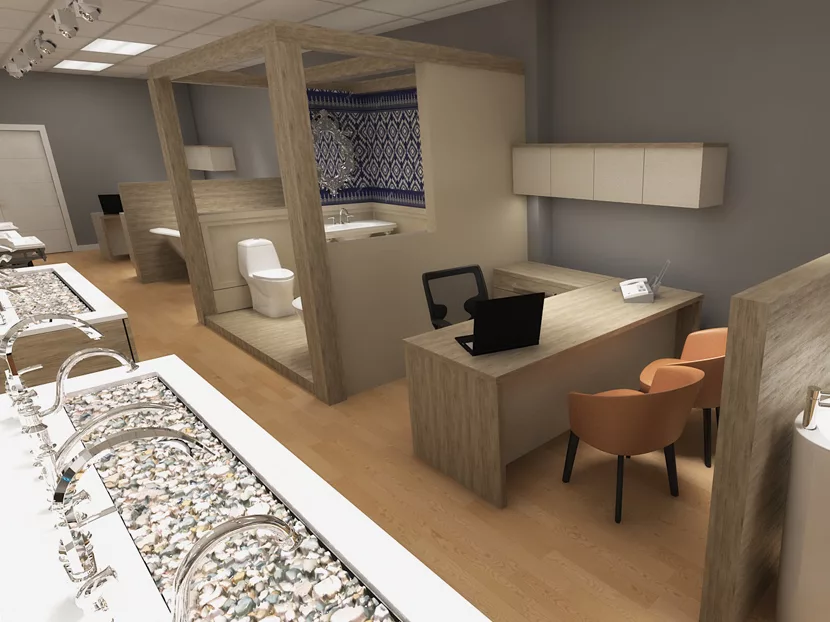The kitchen and bath industry is a small but booming one, dedicated to improving the lives of clients with great products, personalized service and expert advice. Even with the popularity of internet shopping, decorative plumbing showrooms have maintained their place in the retail landscape, with many showrooms still owned and operated by families.
The small- to mid-sized teams working in these showrooms are a mix of people in a variety of roles — management, merchandising, sales and design. Members often wear more than one hat. Responsibilities are shared, meaning that when one person can’t (or doesn’t) pull their weight, everyone feels it. It’s a balancing act for any showroom manager, who must watch the numbers, keep customer satisfaction high and make sure everyone on the team is doing their job.
But is it enough for salespeople and other staff to just “do their jobs”? In most showrooms, it isn’t.
Let’s look at the reasons why. First, unhappy staff members are more likely to skip shifts, lack the energy expected of a showroom salesperson and be less inclined to learn the many details associated with selling kitchen and bath products. In this industry, passion is key.
Second, someone coming into work and going through the motions has an eye on the door (and an eye out for another job). With all the effort and expense a company invests in training an employee, high turnover is the last thing a showroom manager wants to deal with.
Employee Retention Tips
The costs of losing an employee can vary but no matter what study or anecdote you look at, it is a major expense. The average cost to replace lower-wage employees earning under $30,000/year is about 16 percent of their annual salary. The cost goes up for higher-paid employees — up to 20 percent of the annual salary for the position. Some say the cost can even be twice the annual salary. That is a basic calculation; there are likely to be many more costs associated with losing one employee and hiring a new one.
The person in charge of hiring staff members has to advertise, interview, screen and hire, then start an intensive training process. Product names, brands, how products work, price points; the kitchen and bath world is all about details and customers expect showroom staff to know what they are talking about. It can take a new employee an estimated one to two years to reach the productivity levels of the person replaced.
High turnover has an impact on overall morale. Other workers wonder why people are leaving and may lose confidence in workplace culture; this can result in productivity loss or other employees leaving outright.
So, what can a showroom do to keep employees feel happy, engaged and valued? It takes more than the occasional team meeting.
• Get everyone involved. For a plan to have an impact, every member of the team has to be on board. It is the case with any plan, from keeping a showroom clean to promoting new products to hitting sales targets. Instead of management walking in and sharing a plan devised in a closed meeting, a brainstorming session with relevant staff will result in fresh ideas and employees who feel valued.
Staff involvement goes beyond sales and customer service. Changes to the showroom, whether it is something small like a display or something major such as a full renovation, should involve the input of every member of the team. Asking for staff input goes farther than validating an employee’s hard work and value to the company.
Employees are 10 percent more likely to stay if they see an opportunity for growth within a company. Since advancement opportunities may be scarcer in a small family business than in a large corporation, it’s a good idea to make employees feel as if they are an essential part of the business.
• A sales strategy built by the staff. When it comes time to develop a strategy for showroom sales, go to the people who know the clients best. If salespeople feel heard and see their advice put into action by management, they will be more engaged with their work and continue to bring important information about customer behavior back to management.
With the assistance of those who will be most impacted by these decisions, develop a sales strategy that is strong but flexible — let people know the main goals but allow them to use the skills they are most comfortable with. At the same time, offer product training and education support so staff can get the details they need to make sales. The best salespeople are the ones who believe in what they are selling; they can only do it if they know the products inside and out.
• Build a culture. The environment we work in has a huge impact on how we feel about going to work and what we do when we’re there. Unfortunately, it’s one thing to say you want to foster a positive, healthy work environment but it’s another thing to implement one. Team-building activities and other efforts to build up company culture do work; employees who don’t feel engaged by their workplace culture are 15 percent more likely to think about switching jobs.
One way to foster a positive work environment and culture (beyond motivational posters) is to get involved with local charities or events. Ask your staff members if there is a cause close to their hearts the business can sponsor or raise money for and encourage the whole team to participate in local fundraising initiatives.
Not only is it good for the employees and the community, it is also good for the brand. One study showed that 90 percent of Americans are more willing to trust companies that contribute to social or environmental causes.
• Team dynamics matter. Everyone on the team, from supervisors to salespeople, should work well together. Supervisors, for example, should be transparent and communicate both the company’s needs and employee’s tasks clearly and consistently. Conflicts with management are a leading reason for people to leave jobs. Employees with supervisors who respect and value their ideas are 32 percent less likely to seek another job.
Equally as important for an employee are his or her colleagues. That isn’t to say everyone should be best friends. However, a group of people who work well together, recognize each other’s strengths and weaknesses, and support each other will see more success than a group of people who don’t trust each other.
• Virtual recognition. If the showroom or brand has a blog or social media accounts that need constant feeding, consider asking staff members to contribute. They can write up guest blog posts or suggest ideas for online content. Content ideas are a great subject for brainstorming sessions as well.
As not everyone is comfortable writing, you may find some staff members are great at taking photos in the showroom or of projects, or finding interesting articles to share on the showroom’s social media sites.
For staff members who design or work with brands, developing content is good for their portfolios and they will be more likely to promote the content within their own professional networks. If no one on the team is interested in producing content, showroom management can feature staff profiles on the web or social media. These profiles will be shared by the employees, making it one more way to get the showroom’s name out in the community.
• Respect personal lives and time. Good management can fulfill the needs of the organization while also understanding and being sympathetic to the needs of the sales staff. The people on the ground should not suffer needlessly for better numbers. One of the leading causes of employee complaints has to do with staffing issues.
When people don’t feel they have proper support during their shifts or are called in last-minute due to poor scheduling, it can lead to resentment and low morale. One way to ensure there aren’t too many staffing or scheduling problems is to involve employees in the scheduling process or implement a self-scheduling program.
Part of scheduling will necessarily include vacation days and personal days, which should be respected. Burnt-out employees think about quitting more often than those with proper support (they’re 13 percent more likely to stay with a job).
• Recognize, appreciate and encourage. It may seem that a smaller business would be better at retaining its employees than a large corporation. However, no matter what the size of the business, keeping employees happy enough to stick is a get-what-you-give situation. That is to say, any sized company can have great retention rates as well as lose employees as fast as they hire them.
By putting some time and effort into making employees feel valued, heard and appreciated, showrooms big and small can keep turnover to a minimum and offer a great service thanks to happy employees.






